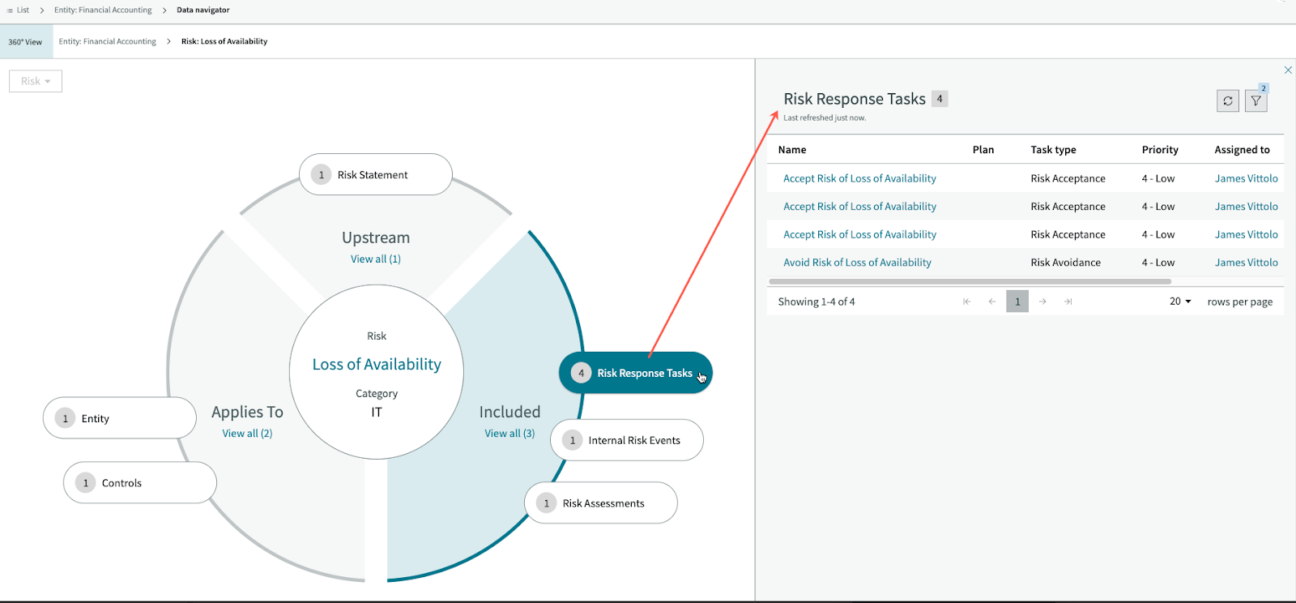In September, ServiceNow announced its new release, code-named “Rome”, and as usual we wanted to give our readers a brief overview of the new features that grabbed our attention. The ServiceNow GRC domain which this article focuses on has been significantly improved in the following areas:
- User Experience with workspaces, allowing a single-pane view
- Privacy Management, a new application
- Business Continuity Management, enhancing a visualization approach to crisis management
New User Experience with Workspaces
In the Rome release, ServiceNow brings an important upgrade to the GRC User Experience with workspaces for Compliance, Risk, Audit, Privacy and Vendor Risk professionals.
A workspace is a graphical user interface which shows all the tools, forms, dashboard and related lists tailored to your unique role. Workspace allows a consolidated view, making it easier to track status, prioritize and respond to GRC tasks such as a risk assessment or a control execution. The main day-to-day activities are now consolidated into one homepage, reducing the need to navigate between your modules, forms, list and dashboards.
4 workspaces are available Out Of the Box tailored for GRC users:
- Risk Workspace tailored for risk professionals such as IT Risk Manager or Operational Risk Manager
- Compliance Workspace designed for compliance managers and analysts
- Vendor Risk Workspace for users engaged in assessing the risk of third-parties, such as Vendor Risk analyst
- Privacy Workspace making easier for you to manage your private impact assessment and track your sensitive data
- Audit Workspace so auditors can easily navigate through their audit tasks
Additionally, ServiceNow released a new First Line Experience called “Risk Portal” based on Service Portal functionality. First Line Experience available for all employees involved in the execution of controls and/or remediation of issues. Risk Portal will simplify the interface for business users and allow them to report risk events and issues as well as respond to other tasks like risk assessment, audit evidence request, control execution task etc.
Rome comes with a UI Builder meaning that workspaces are fully configurable and can be easily tailored to specific roles and business needs. It is fast to build, easy to change and to upgrade.
ServiceNow also released a new feature related to user-interface called the “360° View of Relationship”. This relationship view helps to visualize complex and interconnected GRC data. From a given record, you will be able to visualize all the related data. For example, you can access all indicators, issues, risks, controls and policies which apply to a given GRC entity from a single view.

Privacy Management
In the Rome release, ServiceNow strengthens its positioning in the area of GRC by introducing an application called “Privacy Management”.
Today, organizations must maintain compliance with a group of local and international legislation aimed at protecting individual data rights. Concerns about privacy protection are rising, governments and regulatory authorities are taking initiatives to regulate the use of private data. In order to protect their customers, companies must establish a culture of privacy within all its units which operate with personal information. They need to keep control on the type of data they process and make sure that the storage and the processing of such critical data are secure. Employees, customers and partners trust you to keep their data safe. This makes accurately assessing privacy posture difficult as regulations are continually evolving, data is siloed and processes are often manual.
ServiceNow Privacy Management is a new extension to the IRM suite of applications using the same platform and data model to prioritize and manage risk. It will help organizations to unify the enterprise-wide data privacy governance on a single platform to gain visibility on privacy risks and break down siloed data.
Concretely Privacy Management allows organizations to discover where sensitive information is stored and understand how it is used. Data discovery can be done manually or automatically thanks to integration with BigID.
Organizations can trigger and automatically score privacy assessments. When a new activity, such as a changed process or application, involves personal information, it triggers a Privacy Impact Assessment (PIA) which is assigned to business owners and automatically calculates the risk score based on results gathered in the PIA. You can then apply specific controls related to policies and authority documents and send control attestations to business users. Same as for the other modules of GRC, if there are any failed controls based on responses to the control attestations, privacy issues are automatically created for further remediation.
Business Continuity Management
ServiceNow brings 2 new enhancements to its business continuity management application.
- A GRC Crisis Map
- Crisis Management integration with Everbridge Notification
The new GRC Crisis map was designed to make disaster information easy to find, use and share. It will allow organizations to visualize crisis impact on their perimeter to simplify coordination and improve response. This is particularly useful for organizations with multiple sites in different locations.
The crisis map includes the latest satellite imagery and available information like storm paths, flood zones, evacuation routes, shelter locations, earthquakes, and power outages. All this available information will help to prepare better recovery plans and to prioritize crisis resources to where they will have the greatest impact to protect organizations’ customers, employees, products and services.
Concretely, the crisis map provides a collection of alerts related to weather, hazards, and emergency preparedness response. This includes data sourced from providers including weather.gov, earthquake.usgs.gov, tsunami.gov, and other official agencies.
In a nutshell, the GRC crisis map fulfills the need to visualize the impact on your organization, simplify coordination and improve response, and adjust work based on evolving and expanding needs on the ground.
The second enhancement focuses on the integration of ServiceNow BCM Crisis Management with Everbridge Notification. It enables organizations to send notifications to crisis team members or any individuals and groups using lists, locations and visual intelligence. Notifications keep stakeholders informed before, during and after crises by leveraging a single access point to notify contacts and manage contact data across multiple distributed data stores. Stakeholders will gain awareness and information relating to crisis events and business disruptions impacting their operations.
ServiceNow Rome GRC: Closing notes
We believe that this release brings key improvements to GRC with this set of announcements specially when it comes to User Experience. ServiceNow tackled the need for an improved user interface. Thanks to the new persona-based workspaces and new Risk Portal, it will change the day-to-day ways of working with GRC applications and will definitely increase user adoption across organizations.
Don’t hesitate to contact us to receive the most up-to-date information regarding ServiceNow and its products. Feel free to reach out in case you are interested in a demo or professional services.
Disclaimer: Information and screenshots used in this article are coming from official ServiceNow documentation released for the Rome upgrade.

Certified ServiceNow Experts at your service
ServiceNow can empower your employees and clients with digitalized workflows, and Devoteam, as the #1 preferred Partner in the EMEA, is eager and ready to help make your digital transformation journey a success. Ready to see what we can bring to the table?

